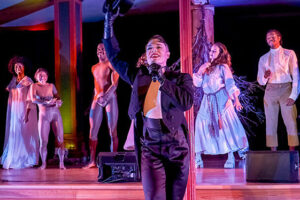

Now, I am not going to claim that there is not now and never has been such a thing as an artist with contempt for his audience– you of the cher public may well be able to offer examples of that phenomenon. But in Castorf’s work at Bayreuth and (here comes the canard part) in the work of artists in general, “contempt” doesn’t seem to me to be much of a motivator.
What perhaps reads as contempt is the absence of an element so familiar in much art that we take it for granted, I.e., the expression of the artist’s desire to be loved and admired by the public. This expression can take many forms, from open pandering to simple tweaking of the art to make it more user-friendly. And the “target” of that desire might be a broad public or it might be the artist’s fairly narrow coterie of fans.
Now, I’m not saying this desire to please is necessarily a bad thing; on the contrary. There’s a lot of art whose initial appeal, or even primary appeal, is that it offers pleasure. We want to experience beautiful, sensuously pleasing art just as we prefer delicious food to bland or distasteful food, and, on perhaps an even shallower level, just as (most other things being equal) we prefer the company of physically attractive people to those not so aesthetically pleasing.
So pleasing “friendly” art has a sort of shortcut to the mind through the emotions, and an artist we like or admire or adore by definition creates a kind of friendly art: we love the artist and so we go into the experience of observing the art predisposed to like it, to get to know it, to give it the benefit of the doubt. As such, artists learn, consciously or unconsciously, how to make themselves and their art friendly.
Now, where the problem comes in is that we have come to expect a certain level of “lovability” from art, a sort of baseline cordiality, and when that level is not met, we can get a negative first emotional impression that a colors our understanding of the art.
For example, creators of works performed for an audience generally understand that the public has a range of “acceptable” durations. A program that is only 15 minutes long is as unlikely to appeal to the general public as a presentation that lasts 12 hours. The one seems hardly worth the travel time, and the latter impinges too heavily on the spectator’s everyday life.
And so a show that is extremely short or extremely long feels to the observer like a breach of etiquette, and from there– especially if the spectator feels somehow constrained to attend this presentation, feelings of resentment creep in. Who is this guy to think I have nothing better to do with my time, anyway?
And as it is with duration, there are a number of other “friendly” conventions of art that, if not observed, can read as deliberate rudeness, and therefore as evidence of contempt for the audience.
One of those “friendly” conventions I think we look for in art is consistency. The whole thing should feel of a piece, or, if the experience feels fragmented, then that fragmentation should somehow be “consistent” in that it is the theme of the piece. (For example, we don’t experience Buchner’s Woyzeck as a play that was hastily cobbled together and therefore evidence of the playwright’s disdain for his audience. Rather, the fragmentation feels organic to the dramatic theme of the title charactr’s splintering sense of reality.)
Well, what I see thus far in Castorf’s Ring is a vast and erratic inconsistency: one moment feels like parody, another like pastiche, yet another a faithful and emotionally true interpretation of.the stage directions in the score, as literal, if not as trite, as something out of Otto Schenk.
And then there’s the hooker in the cocktail dress who turns up in Die Walkuere. She manifests first as a video projection, an effect used in this production more sparingly than in the previous night’s Rheingold, and in a different format. In keeping (perhaps) with the early 20th century setting of this music drama, the video is projected not on a modern LED/Jumbotron but instead in flickering black and white on unrolled panels of muslin, a very homemade effect.
Anyway, just about the time Siegmund’s “Winterstuerme” begins, on the other side of then stage, there’s this movie or live video feed of a stout middle-aged woman in a slip, and she’s eating a cake with decreasing delicacy. At the point she’s grabbed the confection with both hands and is licking the icing, she pauses to answer an antique telephone, chats about something that looks rather serious, then hangs up (depositing the receiver atop the dessert) and, vamping the camera, slips into a cocktail dress. Then she tucks back into the cake and the video cuts to what looks like documentary footage of the Russian revolution era.
Well, yes, that was strange. But then the woman turns up again, this time in the flesh, toward the middle of the Wotan/Fricka argument. She just sort of scampers across the stage in her wrapper, and the gods don’t look particularly surprised to see her.
She is, I guess, a random mistress of Wotan’s? Since at this point in the proceedings he is in the guise of an oil prospector of the period (complete with an outrageously unconvincing beard he later doffs) and Fricka is (at a guess) dressed as a tribal princess from Asia Minor, and their scene is played before a towering barn-like structure that houses oilfield machinery… well, who knows?
I don’t, and I certainly don’t know what Castorf is up to in a lot of other places too. But it’s not inept, and while there are stretches, long stretches in fact, I find boring, I’m not offended. Frank Castorf may not like me particularly, but, so far at least, I honestly don’t think he hates me either.
Photo: Bayreuther Festspiele/Enrico Nawrath























Comments